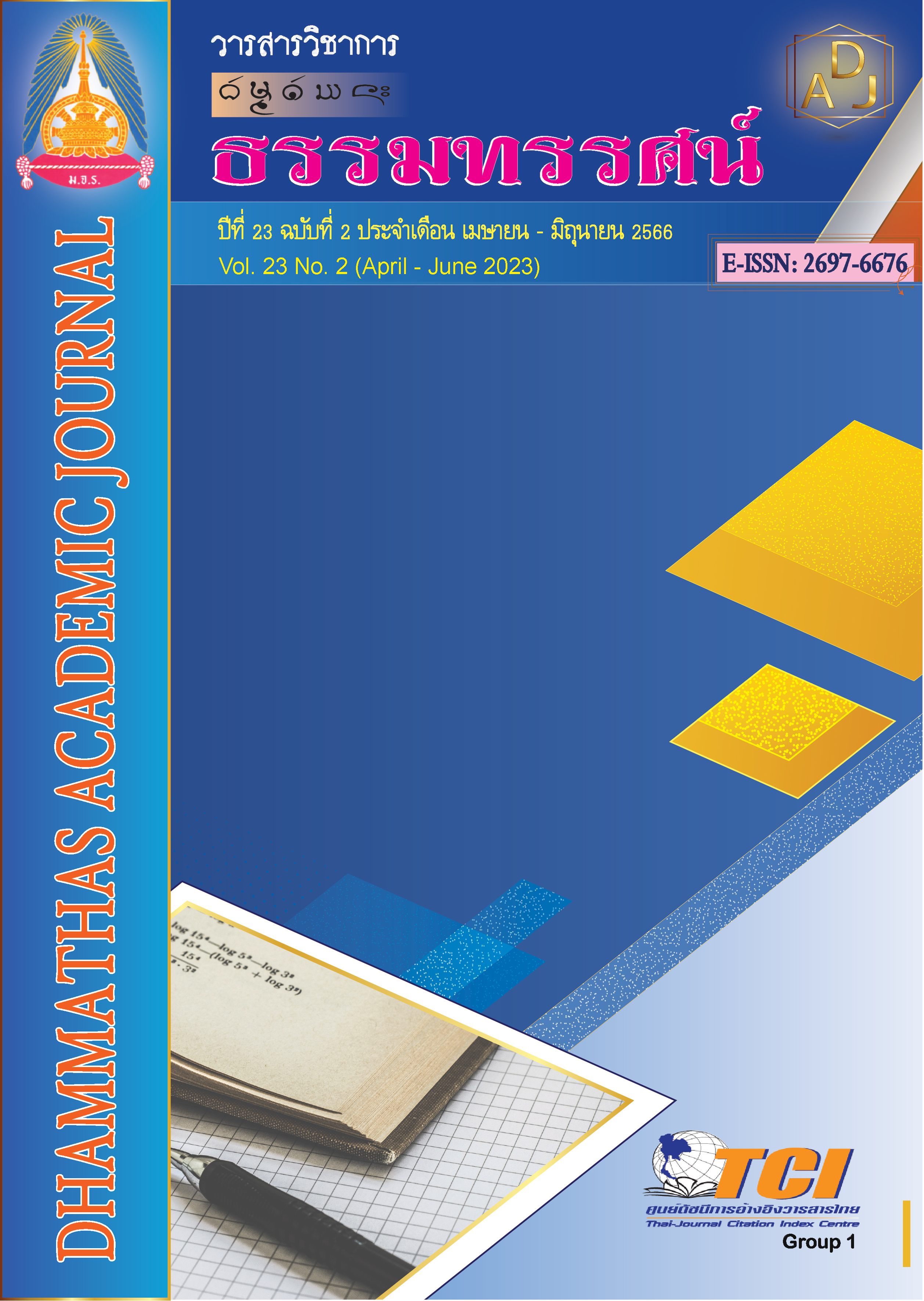A Model of School Administration in the 21st Century according to Buddhist Doctrines of School Administrators under the Primary Educational Service Area Office
Main Article Content
Abstract
The objectives of this research were 1) to study the state of school administration in the 21st century, 2) to create a model for school administration in the 21st century, and 3) to propose a model for school administration in the 21st century based on the Buddhist doctrines of school administrators under the primary educational service area office. Mixed method research was used in this study. Qualitative research to studying the document, Interviews with 5 key informants and focus group discussions with 9 experts, research Instrument used documented study forms, interview forms, and focus group discussion guides. Data were analyzed by content analysis. Quantitative research to study the state with 378 samples, and to assessed with 371 samples, research Instrument used questionnaires and assessment forms. Data were analyzed by using percentage, mean, standard deviation, and priority needs index.
The results of the research found that:
1. The state of school administration in the 21st century overall at high level, expected condition overall at highest level, and first need was academic administration.
2. The model consists of 5 parts: 1) environment is setting work standards, resources, and physical state, 2) objectives is to develop educational institutions to keep up with changes, 3) educational administration process scope of educational administration, Iddhipada 4 Principles, and administrative processes, 4) structure 5) conditions for success through cooperation from stakeholders.
3. Proposals and assessment of model in usefulness, and accuracy at the highest level. Possibility, and suitability at a high level and can be used for real.
Article Details

This work is licensed under a Creative Commons Attribution-NonCommercial-NoDerivatives 4.0 International License.
เพื่อให้เป็นไปตามกฎหมายลิขสิทธิ์ ผู้นิพนธ์ทุกท่านต้องลงลายมือชื่อในแบบฟอร์มใบมอบลิขสิทธิ์บทความ ให้แก่วารสารฯ พร้อมกับบทความต้นฉบับที่ได้แก้ไขครั้งสุดท้าย นอกจากนี้ ผู้นิพนธ์ทุกท่านต้องยืนยันว่าบทความ ต้นฉบับที่ส่งมาตีพิมพ์นั้น ได้ส่งมาตีพิมพ์เฉพาะในวารสาร วิชาการธรรม ทรรศน์ เพียงแห่งเดียวเท่านั้น หากมีการใช้ ภาพหรือตารางของผู้นิพนธ์อื่นที่ปรากฏในสิ่งตีพิมพ์อื่นมาแล้ว ผู้นิพนธ์ต้องขออนุญาตเจ้าของลิขสิทธิ์ก่อน พร้อมทั้ง แสดงหนังสือที่ได้รับการยินยอมต่อบรรณาธิการ ก่อนที่บทความจะได้รับการตีพิมพ์References
กฤษธรา ยองใย. (2561). ผู้บริหารสถานศึกษาในศตวรรษที่ 21. การประชุมวิชาการและนำเสนอผลงานการวิจัยระดับชาติ ครั้งที่ 2 GRADUATE SCHOOL CONFERENCE 2018, 30 พฤศจิกายน 2561, (หน้า 37-44). กรุงเทพฯ: มหาวิทยาลัยราชภัฏสวนสุนันทา.
นูซี มะเด็ง. (2564). รูปแบบการบริหารสถานศึกษาแห่งความสุขโรงเรียนราชประชานุเคราะห์ 39 จังหวัดนราธิวาส. วารสารวิชาการบัณฑิตวิทยาลัยสวนดุสิต, 17(2), 95-112.
ผ่องศรี วาณิชย์ศุภวงศ์. (2546). เอกสารคำสอนระเบียบวิธีวิจัยทางการศึกษา. ปัตตานี: ฝ่ายเทคโนโลยีการศึกษา มหาวิทยาลัยสงขลานครินทร์ วิทยาเขตปัตตานี.
พรพิมล แก้วอุทัศน์ และกานต์ เนตรกลาง. (2564). ทักษะการบริหารในศตวรรษที่ 21ของผู้บริหารสถานศึกษา สังกัดสำนักงานเขตพื้นที่การศึกษาประถมศึกษาบุรีรัมย์ เขต 3 ตามทัศนะของครู. วารสารวิชาการคณะมนุษยศาสตร์และสังคมศาสตร์, 12(1), 111-126.
พรรณิภา งามเลิศ และคณะ. (2563). ผู้บริหารสถานศึกษาในศตวรรษที่ 21 ตามหลักสัปปุริสธรรม 7. วารสาร มจร อุบลปริทรรศน์, 5(2), 798-803.
พัชราวลัย สังข์ศรี. (2561). พุทธวิธีกับการบริหารการศึกษา. Veridian E-Journal, Silpakorn University, 11(1), 1260-1270.
พิเชษฐ์ โพธิ์ภักดิ์. (2553). การพัฒนารูปแบบการบริหารโรงเรียนนิติบุคคล สังกัดสำนักงานคณะกรรมการการศึกษาขั้นพื้นฐาน. (วิทยานิพนธ์ครุศาสตรดุษฎีบัณฑิต). กรุงเทพฯ: จุฬาลงกรณ์มหาวิทยาลัย.
วิจารณ์ พานิช. (2558). แนวโน้มการบริหารสถานศึกษาในศตวรรษที่ 21. สงขลา: คณะศึกษาศาสตร์และศิลปะศาสตร์ มหาวิทยาลัยหาดใหญ่.
สมหมาย เทียนสมใจ. (2556). รูปแบบการบริหารงานที่มีประสิทธิภาพของสำนักงานเขตพื้นที่การศึกษาประถมศึกษา. (วิทยานิพนธ์ปรัชญาดุษฏีบัณฑิต). กรุงเทพฯ: มหาวิทยาลัยศิลปากร.
สำนักงานคณะกรรมการข้าราชการพลเรือน. (2563). กำลังคนภาครัฐในศตวรรษที่ 21 (Workforce in The 21st Century). เข้าถึงได้จาก https://www.ocsc.go.th/sites/default/files/document/ocsc_e-journal-year-62-2-2563.pdf
สุทธิศักดิ์ นันทวิทย์ และสจีวรรณ ทรรพวสุ. (2558). รูปแบบการบริหารสถานศึกษาขั้นพื้นฐานในศตวรรษที่ 21 ของสำนักงานเขตพื้นที่การศึกษามัธยมศึกษา เขต 2. (วิทยานิพนธ์ครุศาสตรมหาบัณฑิต). กรุงเทพฯ: มหาวิทยาลัยศิลปากร.
Likert, R. (1967). The Method of Constructing and Attitude Scale. New York: Wiley & Son.

